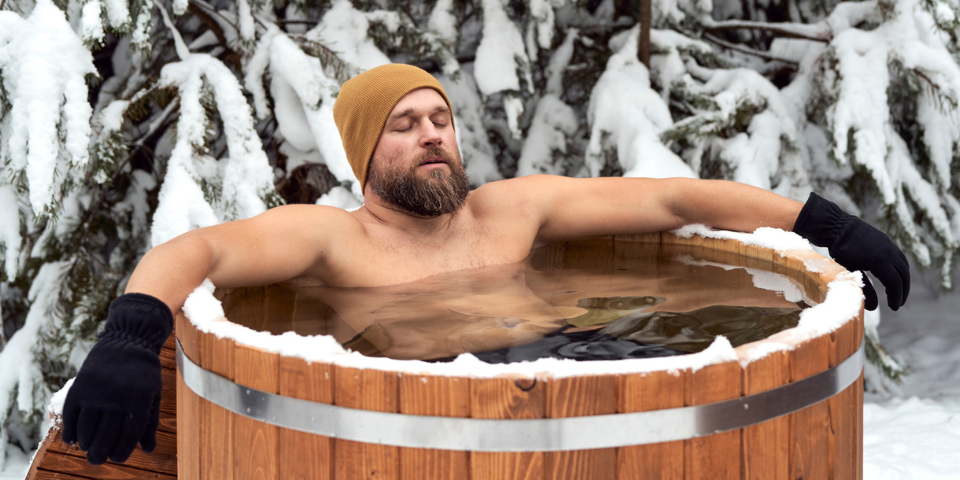Physical Address
304 North Cardinal St.
Dorchester Center, MA 02124
Physical Address
304 North Cardinal St.
Dorchester Center, MA 02124

A contrast bath (or contrast water therapy) is the technical term for a warm bath, followed by a cold bath, then a warm bath, then a cold bath (repeated for about 20 minutes). This recovery modality may be more beneficial than just an ice bath if you’re looking seriously recovery benefitssuch as reduced inflammation, pain and swelling.
Contrast bathing — a stark contrast to normal convalescents foam rolling and protein powders — is not for everyone. But if you’re feeling adventurous and can handle a few minutes of cold discomfort, consider taking the plunge.


In addition to inducing teeth grinding and the occasional swear word, contrast bathing—or switching between hot and cold water immersion—causes the body’s blood vessels to alternate between vasodilation (relaxing and opening blood vessels) and vasoconstriction (shrinking the space inside a blood vessel).
The idea is that the repeated opening and closing of the vessels creates a pumping effect that helps bring fresh, oxygenated blood to the body’s tissues as it is flushed. waste productsthus reducing swelling, inflammation, stiffness and discomfort.
“Contrast baths are a great way to reduce inflammation and speed up the healing process,” says Steve Hruby, doctor of chiropractic and founder of the company. Kaizen Progressive Health in Scottsdale, Arizona. “They can also be helpful pain reduction and improvement range of motion.”

For such a simple and affordable therapy, contrast baths offer a number of research-backed benefits.
As mentioned earlier, contrast baths can help delayed onset of muscle pain (DOMS), an unpleasant exercise-induced condition that can interfere with athletic performance. But research shows that contrast baths can also help non-athletes with everyday pain.
Contrast baths can also help reduce swelling caused by injuries, which can be painful and inhibit mobility. A study involving participants with ankle sprains found that using contrast baths three days after the injury helped reduce swelling better than heat therapy.
In one study published Journal of Strength and Conditioning Researcha group of recreational athletes performed a leg workout designed to induce DOMS. After training, one group rested for 15 minutes while the other worked on contrast water therapy.
According to the study, “Contrast water therapy (CWT) was associated with less reduction and faster recovery of strength and power… compared to passive recovery.”
Evidence that contrast baths boost immunity is still largely anecdotal. However, one study found that people who took daily contrast showers took significantly less sick leave from work than those who didn’t.


“There are many ways to do a contrast bath, but the basic idea is to alternate bodies of hot and cold water,” says Hruby. “I usually recommend starting with two minutes in hot water, followed by one minute in cold water. You can repeat this cycle for up to 20 minutes.”
How cold and hot depends on what’s available to you (and what you can personally tolerate), but protocol for most scientific studies, it includes a hot temperature of 100 to 104 degrees Fahrenheit (37 to 40 degrees Celsius) and a cool temperature of 46 to 50 degrees Fahrenheit (seven to 10 degrees Celsius).
While contrast baths are often associated with full-body immersion, you can also submerge just an inflamed part of the body or an injured area, such as an arm or ankle. Depending on the injury or condition, your doctor may also recommend doing some gentle exercises or movements while the body part is submerged, such as bending the ankle or opening and closing the hand.
Depending on the condition or severity of the injury, contrast baths can be done daily or several times a day.
Some training and physical therapy facilities are equipped with tubs specifically designed for contrast baths. However, you can create a similar experience with a cold lake or unheated pool and a Jacuzzi or hot tub.
If you don’t have access to multiple bodies of water, try a contrast shower in your own bathroom by following the same contrast bath ratio between hot and cold – just turn the knob back and forth from hot water to cold water.
Contrast baths do not require special water; plain H2O from your tap will work, as will chlorinated pool water or salty ocean water. The most critical variable is temperature. As stated above, you want your cold water to be between 46 and 50 degrees Fahrenheit (it will feel uncomfortably cold!) and your hot water between 100 and 104 degrees Fahrenheit.
It is important to note that they are contrasting baths no It is recommended for people who have open wounds or who are hypersensitive to low temperatures. And if you have any medical condition, it’s crucial to consult your doctor before trying a contrast bath.